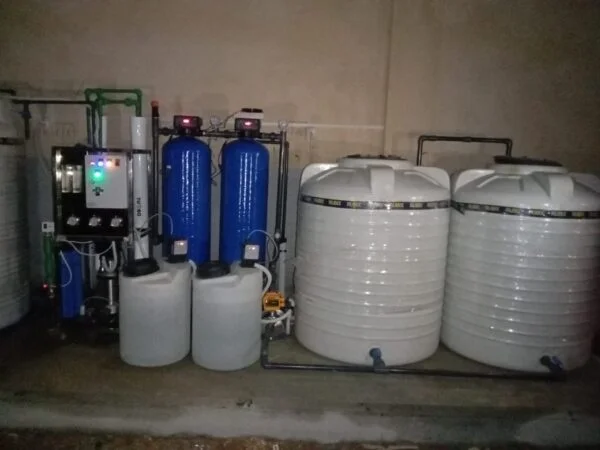What is Reverse Osmosis? Before diving into the explanation of the reverse osmosis process, which is used for water desalination, it is essential to first provide a simple explanation of the osmosis phenomenon, supported by some illustrative diagrams.
Osmosis is a physical force and a natural tendency of water with a high concentration of certain dissolved particles to move through a semi-permeable membrane to an area of water with a lower concentration of dissolved particles. The water will work to reach equilibrium on both sides of the membrane, meaning that the water on both sides of the membrane will become of equal concentration in dissolved particles. The process of Reverse Osmosis requires pushing the water at high pressure, allowing it to pass through the membrane in the opposite direction of what occurs in nature, resulting in the purified water passing through the membrane, while trapping the salty particles in the area of high salinity. Desalination is a separation process used to reduce the level of dissolved salts in saline water to a point where the water becomes suitable for use and drinking. In geographical areas that lack natural sources of pure and potable water, such as rivers, springs, and floods, communities rely on water desalination systems as a reliable, inexhaustible source of water. This began in 1950, when desalination systems became economically viable and utilized simplified technologies that work in various environmental conditions. The acceptable level of dissolved salts in desalinated water is set at 500 parts per million, which is the internationally permitted limit for water used in domestic, industrial, and agricultural applications.
Reverse osmosis works by applying pressure to saltwater to make it flow through a semi-permeable membrane. The membrane allows water to pass through but prevents salts and other contaminants from passing. It is applied for use in water treatment. Without this process, the system must be operated to access fresh water. You can imagine it as trying to push water through a strainer. The strainer allows the water to pass but prevents dirt from passing through. In reverse osmosis, the membrane is the strainer. The amount of pressure required depends on the amount of salts and contaminants present in the saltwater. The higher the concentration of salts and contaminants, the more pressure is needed. Reverse osmosis systems typically use multiple membranes in series. These membranes allow for further filtration and produce purer water.
Below is the complete reverse osmosis process, including the pre-treatment and post-treatment generally required for highly contaminated water:
A) Raw Water Storage Tank
If the inlet pressure of the feedwater is not between 1-3 bar, the RO system will not be able to draw water directly from the well or the supply pipes.
Therefore, having a large drinking water storage tank is an easy way to ensure that the pump lasts as long as possible.
B) Feedwater Pump
A commercial or industrial pump provides the initial pressure for the treatment system.
All of our pumps use high-quality 304 or 316 stainless steel for long-lasting use.
C) Sand Filter
The sand filter system removes all particulate impurities larger than 10 microns using quartz sand to fill the FRP tank.
(d) Activated Carbon Filter
Activated carbon filters are an effective solution for reducing organic compounds, unpleasant taste and odor, and chlorine from water.
(e) Water Disinfectant
Water softeners are designed to remove water hardness and calcium and magnesium ions for small reverse osmosis systems.
(f) Anti-Scalant Chemical Dosing System
For larger reverse osmosis systems with very high hardness, anti-scalant dosing systems are used to inject anti-scalant chemicals, which help prevent membrane fouling.
(z) Micron Filtration System
Using a 1 or 5-micron PP filter cartridge helps remove sediments and protect the membranes.
(ḥ) Reverse Osmosis System
A reverse osmosis system can produce pure water at various daily capacities. Typically, the wastewater can be discharged into the drain, but it is advisable to check with local water authorities in case special handling is required.
(ṭ) High-Pressure Pump
The high-pressure pump is very important, as a pressure of 10 to 15 bar is needed to re-pressurize the permeate water to the end-use point. This pump should be made of stainless steel to prevent any contamination of the permeate water.
(j) Ultraviolet (UV) Water Sterilizer Unit
The ultraviolet (UV) sterilizer is placed before or after the storage tank, serving as a final disinfection device.
(k) CIP System
For larger capacities, typically over 3000 LPH, a CIP (Clean-In-Place) system is usually used.
It involves circulating the cleaning solution across the membrane surface to remove product fouling, thereby extending the membrane’s lifespan.
- (l) Product Water Tank
The permeate water from the reverse osmosis system typically goes into a large storage tank.
Operating Procedures for Reverse Osmosis Equipment:
1.Before starting the system, the operator must be familiar with the name and function of each instrument on the main reverse osmosis machine's electronic control panel, as well as the installation and circuit diagram of the instruments on the panel.
3.If it's the first start-up, you should open the outlet pipe of the activated carbon filter to the drain valve, visually monitor the outlet, and ensure that the water is clean without any carbon powder. Then close the drain valve. Next, open the bottom drain valve for the easy-to-penetrate microfiltration filter and close the drain valve once the water quality is clean.
3.Check the pre-treatment system of the reverse osmosis equipment and the main motor components to ensure they are in normal condition. Adjust the open and close settings of each valve to ensure smooth operation of the water passage.
4.Normally open the water inlet valve for the booster pump, and slightly open the water pump through the backflow valve, adjusting it to a moderate position.
5.Close the bypass filter control valve and open the sand filter inlet valve and outlet valve. At the same time, close the control valve on the carbon filter bypass pipe and open the water inlet valve and outlet valve for the carbon filter.
6.Normally open the thick water control valve for the reverse osmosis equipment, and adjust the high-pressure pump throttling valve to the moderate position.
7.Open the exhaust valve at the top of the filter and close the exhaust valve after the water pressure stabilizes for the system.
8.Turn on the four three-phase air switches and the single-phase air switch in the low-voltage distribution equipment and send electricity.
9.Connect the sand filter, carbon filter, and automatic water purifier to a 220V socket to power them on, then set the controller to operate.
10.The main electrical control panel for reverse osmosis is set from the off switch to the open operating position. Turning on the power opens the solenoid valve for the water inlet, and both the booster pump and high-pressure pump start simultaneously.
11.When the main reverse osmosis motor power switch is turned on, the settings in the microcontroller unit will open the flow solenoid valve, and the main reverse osmosis motor will automatically flush. Once powered on, the automatic cleaning is performed once. In the event of a power outage, the timer is canceled, returns to zero, and will restart the timer the next time.
12.The reverse osmosis equipment operates when the water pressure is below the set value of the low-voltage switch. The low-voltage switch activates, and the microcontroller unit within the settings will host the high-pressure pump. When the water pressure resumes, the high-pressure pump of the main motor will start automatically.
13.After flushing the main reverse osmosis machine, correctly adjust the throttling valve after the high-pressure pump. The feedwater pressure to the membrane control should not exceed 15 kg/cm². At the same time, adjust the concentration control valve to regulate the flow of purified water.
Advantages of Reverse Osmosis
- Effectiveness in Removing Salts and Other Minerals: Reverse osmosis has a high capacity for removing salts and other minerals from water. It can achieve salt removal rates of up to 99% or more, resulting in extremely pure water.
- Production of High-Purity Water: The reverse osmosis process can produce high-purity water suitable for drinking and industrial use.
- Versatility in Treating Various Water Sources: The reverse osmosis process can be used to treat a wide range of water sources, including seawater, groundwater, and wastewater.
Enhanced Agricultural Productivity: Reverse osmosis enhances agricultural productivity by providing fresh water for irrigation.


